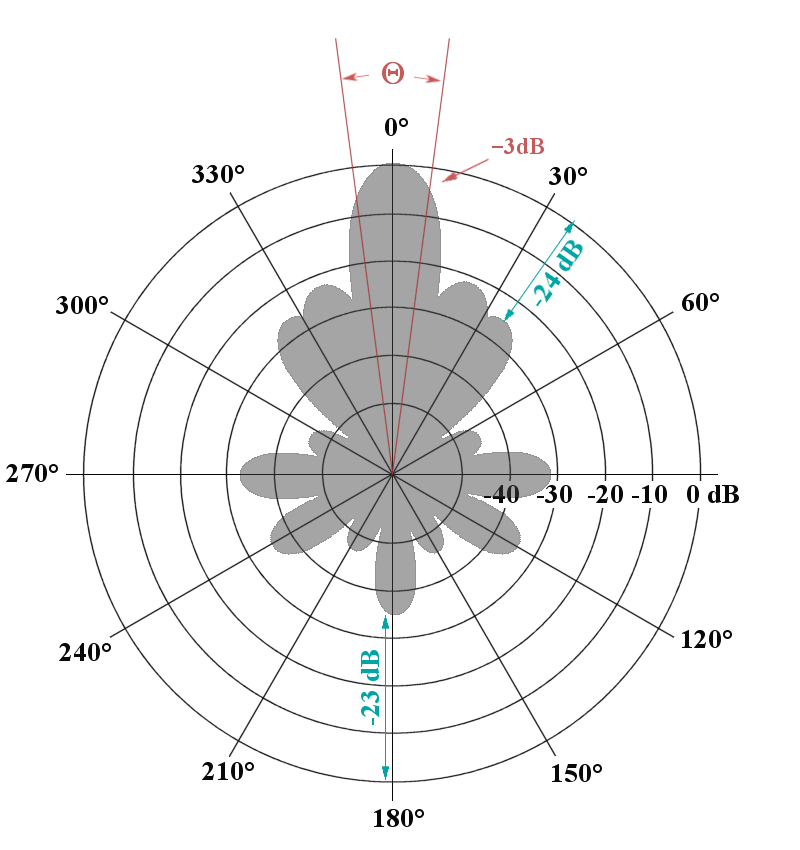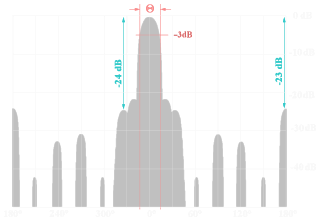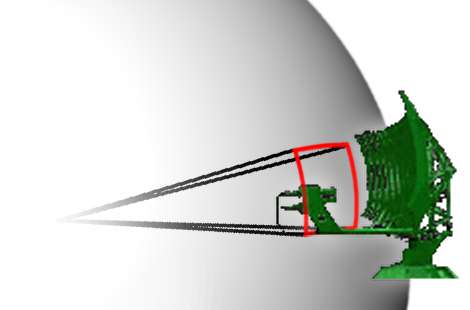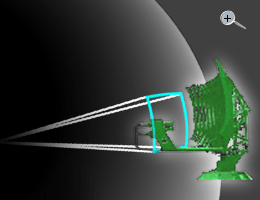Characteristic values of antennas

ratio
Figure 1: Antenna pattern in a polar-coordinate graph
« Characteristic values of antennas »
Characteristic values of antennas
Antenna gain and directivity
Due to the special design of the antenna, the radiation density can be concentrated in certain spatial directions. A measure of the directivity of a lossless antenna is the antenna gain. It is closely associated with the directivity of the antenna. In contrast to the directivity, which only describes the directional properties of the antenna, the antenna gain also takes into account the efficiency of the antenna. It, therefore, indicates the actual radiated power. This is usually smaller than the power provided by the transmitter. However, since this power is easier to measure than the directivity, the antenna gain is used more often than the directivity. Under the assumption that a lossless antenna is considered, the directivity can be set equal to the antenna gain.
A reference antenna is used to define the antenna gain. In most cases, the reference antenna is a lossless hypothetical omnidirectional radiator (isotropic radiator) that radiates uniformly in all directions or a simple dipole antenna which can also be a reference at least in the plane being considered.
For the antenna to be measured, the radiation density (power per unit area) at a point at a certain distance is determined and compared with the value obtained using the reference antenna. The antenna gain is then the ratio of the two radiation densities.
If, for example, a directional antenna generates 200 times the radiation density of an isotropic antenna in a certain spatial direction, the antenna gain G has the value 200 or 23 dB.
Antenna pattern
The antenna pattern is a graphical representation of the spatial distribution of the radiated energy of an antenna. Depending on the application, an antenna should only receive from a certain direction, but should not pick up signals from other directions (e.g. TV antenna, radar antenna), on the other hand, the car antenna should be able to receive transmitters from all possible directions.
The desired directivity is achieved by the targeted mechanical and electrical construction of an antenna. A directivity indicates how well an antenna receives or transmits in a certain direction. It is indicated in a graphical representation (antenna pattern) as a function of the azimuth angle (horizontal diagram) and the elevation angle (vertical diagram).

ratio
back ratio
Figure 2: The same antenna pattern in a rectangular-coordinate graph

ratio
back ratio
Figure 2: The same antenna pattern in a rectangular-coordinate graph
Either a Cartesian or a polar coordinate system is used. The measured values in the graphical representation can have linear or logarithmic values.
Half power beamwidth
The half power beamwidth is the angular range of the antenna pattern in which at least half of the maximum power is still radiated!
Boundary points of the main lobe are thus the points at which the field strength in the room has decreased by 3 dB with respect to the maximum field strength. The angle Θ between these two boundary points is called the aperture angle or half power-beamwidth of the antenna. To simplify the calculations, it is often assumed that the power is evenly distributed within this angle and that no power is available outside.
Beam solid angle
A solid angle is a two-dimensional angle measurement with the variable name Ω. Their unit of measurement is the auxiliary unit Steradiant [Sr]. The beam solid angle ΩA is defined as the solid angle through which all the power of the antenna would flow if it's radiation intensity is constant (and equal to the maximum value) for all angles within ΩA. It is a rather theoretical value but can be approximated for antennas with very large directivity and small side lobes:
| ΩA ≈ Θaz·Θel | where: | Θaz = horizontal half power-beamwidth Θel = vertical half power-beamwidth |
(1) |
There are models in which the projection of the antenna space angle onto the surface is represented as a rectangular profile with the edge lengths of the vertical and horizontal half power-beamwidths (pyramidal solid angle), as well as models in which it is represented circularly or elliptically onto a spherical surface (canonical solid angle).
Sidelobe-attenuation
In addition to the main lobe, the radiation pattern of an antenna contains several side lobes and a back lobe. These phenomena are undesirable because they influence the directional effect unfavorably and also draw energy from the main lobe. The relationship between the main lobe and the largest side lobe is called sidelobe attenuation. Sidelobe attenuation should be as high as possible.
Forward / Reverse ratio
The forward/backward ratio represents the ratio of the magnitude of the main lobe at 0° to the magnitude of the back lobe at 180°. This ratio should also be as large as possible.

Figure 3: The antenna aperture is a section of a spherical surface
Effective antenna area (aperture)
An important parameter of antennas is the effective antenna area called Ae or “antenna aperture”. Under the condition of optimal orientation and polarization, the maximum power that can be obtained from a receiving antenna is proportional to the power density of the plane wave incident at the receiving location. The radiation density of the wavefront is a power per unit area. The proportionality factor, therefore, has the dimension of an area represented by an antenna in an electromagnetic field. This area is called the effective antenna area Ae and is closely related to the directivity D of the antenna, which is also equal to the gain for a lossless antenna:
| D = G·η = | 4π · Ae | ; Ae = Ka·A | Mit: | η = Antenna efficiency λ = wavelength Ae = effektive Antennenfläche A = geometric antenna area Ka = aperture efficiency |
(2) |
| λ2 |
This equation shows a very important relationship: The directional characteristic of an antenna is determined by its geometric size. The larger the diameter in relation to the wavelength, the higher is its directivity.
An effective antenna area can also be specified for linear antennas. It does not necessarily have to agree with the geometric extension of the antenna, which is particularly apparent with wire antennas. The ratio between the two quantities is called the aperture efficiency of the antenna Ka. For antennas with large parabolic reflectors, Ka = 0,6 … 1,0 applies. The effective antenna area of a rectangular horn radiator with dimensions a and b is slightly smaller than the geometric area a·b.
The effective antenna area depends on the radiation distribution over the geometric antenna area. If this radiation distribution is linear, then Ka= 1. However, this high aperture efficiency with a linear radiation distribution also results in strong side lobes. If the side lobes are to be held on a smaller size for the practical use of an antenna, then the radiation distribution must be non-linear, and the effective antenna area is then smaller than the geometric antenna area (Ae< A).
Bandwidth
The bandwidth of an antenna is the frequency range in which the antenna still achieves the required characteristics for:
- spatial distribution (antenna pattern);
- polarization;
- impedance;
- propagation mode.
Most antenna technologies can support operation over a frequency range that is 5 to 10% of the central frequency (e.g., 100 to 200 MHz bandwidth at 2 GHz) due to their resonance characteristics. To achieve wide-band operation requires specialized antenna technologies (e.g., Logarithmic Periodical Dipole Antenna, Tapered Slot Antenna).


